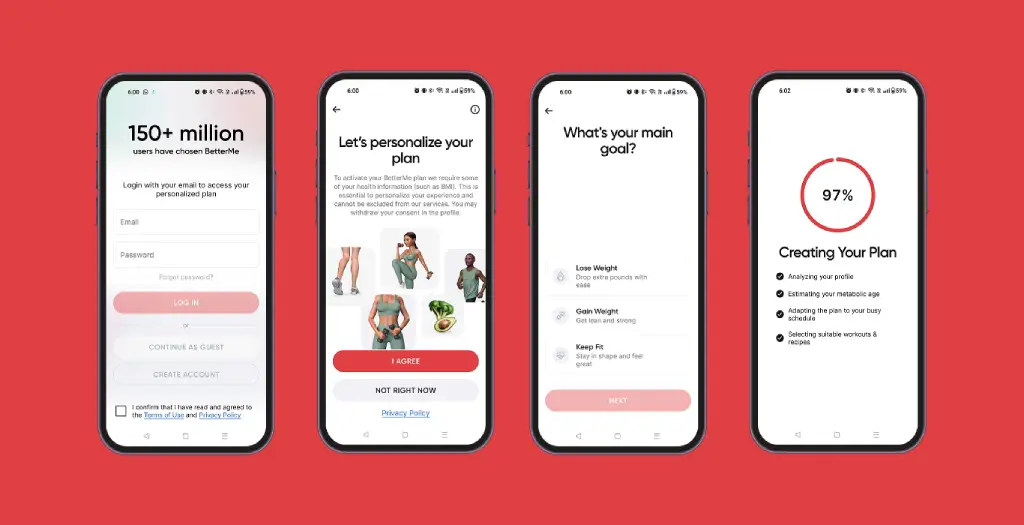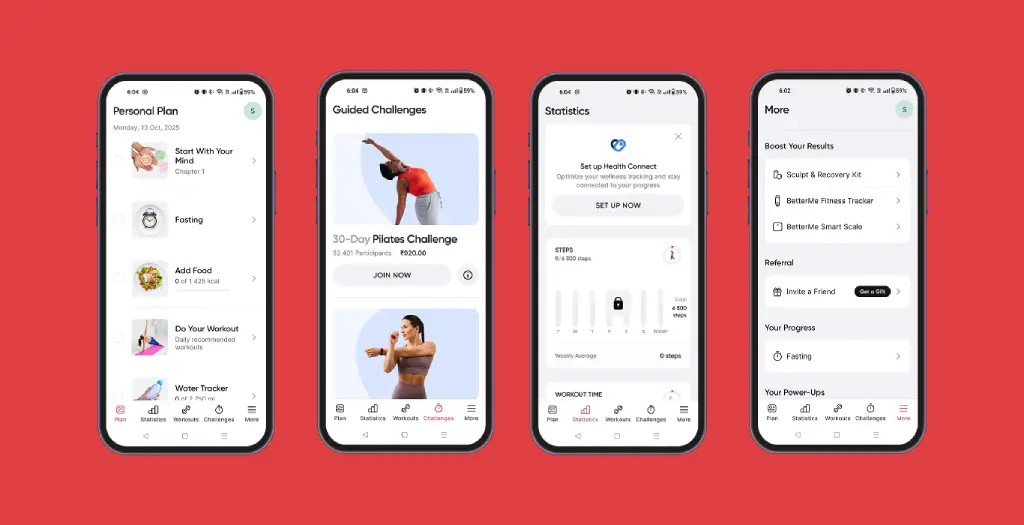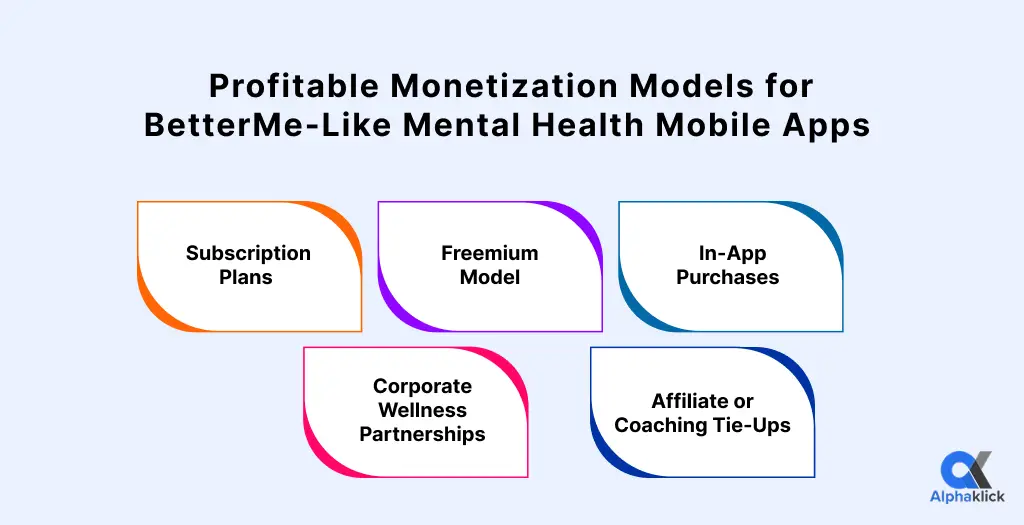Table of Contents
ToggleThe cost to build a mental health app in 2025 typically starts around $20,000 for a basic version and can go up to $100,000 or more for a fully featured, AI-powered platform like BetterMe.
The exact price depends on how smart, scalable, and personalized you want your mobile app to be, but every dollar counts toward improving real people’s well-being.
Think about it: just a few years ago, therapy meant appointments and waiting rooms. Now, guided meditation, cognitive exercises, and emotional tracking all fit inside a phone.
Mental health mobile apps like BetterMe have redefined mental wellness by making it accessible, private, and empowering, one session at a time.
So, when people ask me, “What does it really take, and cost, to build something like that?”, I don’t just talk about budgets. I talk about purpose, impact, and the technology that makes compassion scalable.
In this blog, I’ll break down the BetterMe mobile app development cost across complexity levels, development stages, and platforms.
You’ll also learn how to plan your own affordable mental health mobile app development strategy, avoid unnecessary spending, and see what really goes into creating a life-changing wellness product.
Let’s start by breaking down the cost from its foundation, how complexity shapes everything from pricing to performance.
Cost Based on Mobile App Complexity
The cost to build a mental health mobile app in 2025 depends on how complex your platform is; the more advanced the features, the higher the cost and mobile app development time.
Here’s a quick breakdown for 2025:
| App Type | Key Features | Estimated Cost (2025) | Development Timeline |
| Basic Wellness App | Guided meditation, mood tracking, reminders, affirmation cards, user profiles, and basic analytics | $15,000 – $25,000 | 2–3 months |
| Mid-Level Mental Health App | AI-based mood insights, chat therapy, personalized dashboards, progress tracking, subscription system, and content library | $30,000 – $70,000 | 5–6 months |
| Advanced Mental Health App | Live video therapy, AI emotion analysis, gamification, wearable integration, advanced analytics, and multilingual support | $80,000 – $100,000+ | 10–12 months |
The BetterMe mobile app development cost typically falls between the mid-level and advanced range, depending on AI personalization and backend integrations.
In my experience, costs rise when adding real-time mood tracking or wearable data sync; both improve engagement but demand stronger infrastructure and compliance.
If you’re starting out, build a lean MVP, test user response, and expand later. It’s the best way to keep your affordable mental health mobile app development efficient and scalable.
For a full breakdown of AI features and pricing, check our AI-powered mental health app guide.
Cost Based on Mobile App Development Stages
Every phase in mental health mobile app development adds to the overall therapy app development cost breakdown, from planning to post-launch maintenance.
Here’s a clear view of how time and cost are distributed across each stage:
| Development Stage | Description | Estimated Cost (USD) | Timeline |
| Discovery & Research | Define app goals, analyze competitors, plan compliance (HIPAA/GDPR), and create wireframes | $3,000 – $6,000 | 2–3 weeks |
| UI/UX Design | Build intuitive layouts, select soothing color schemes, and design user journeys | $5,000 – $10,000 | 3–4 weeks |
| Frontend & Backend Development | Code main features, integrate APIs, develop databases, and implement AI or chat modules | $25,000 – $70,000 | 8–12 weeks |
| Testing & QA | Conduct security, performance, and usability testing to ensure stability | $4,000 – $8,000 | 2–3 weeks |
| Launch & Maintenance | Deploy the app, fix bugs, and provide regular updates and server monitoring | $2,000 – $5,000/year | Ongoing |
Each stage builds the foundation for a reliable, user-friendly product.
Design and research phases are often underestimated, but they’re crucial, especially for mental health mobile apps where comfort and compliance matter most.
Early investment in proper planning and UI/UX design saves up to 25% of future costs. Addressing compliance regulations app cost early also avoids expensive rework after launch.
Cost Based on Mobile App Type (Android, iOS, or Cross-Platform)
Choosing the right platform, Android, iOS, or cross-platform, can impact your mental health mobile app development price by up to 40%. Each option offers different benefits depending on your audience, goals, and budget.
| Platform Type | Highlights | Estimated Cost |
| Android | Large global user base, easy third-party integrations, and flexible publishing options | $25,000 – $80,000 |
| iOS | Premium user segment, higher retention, and strong in-app purchase potential | $30,000 – $90,000 |
| Cross-Platform (React Native / Flutter) | Shared codebase for both platforms, faster launch time, and reduced maintenance costs | $20,000 – $60,000 |
For most startups, I recommend starting with a cross-platform approach using frameworks like React Native. It offers the perfect balance of performance and affordability, allowing you to launch faster, test user response, and save nearly 30% of total costs compared to building two separate native apps.
Working with an experienced React Native mobile app development company in India can further optimize your budget. India-based teams deliver high-quality code, healthcare integrations, and compliance-ready apps at competitive rates, making them a preferred choice for wellness and therapy startups.
Later, once you achieve consistent traction, you can scale into fully native Android and iOS versions for better performance and hardware optimization.
Balancing AI therapy mobile app pricing and performance is key. Cross-platform frameworks make this easier while maintaining smooth functionality, even for complex features like real-time tracking, AI-based recommendations, and wearable integrations.
You can also explore the best mobile app development companies in India to find your perfect tech partner.
Factors That Determine the Cost of a BetterMe-Like Mental Health App
The total mental health mobile app development price isn’t defined by coding alone. Several key factors influence your overall investment, from features and design depth to compliance and where your developers are located.
Understanding these helps you budget smartly and build a scalable, high-quality product.
a. Feature Set & AI Integration
Your app’s capabilities directly shape the overall AI therapy mobile app pricing. Basic tools like journaling or meditation are affordable, while AI-driven personalization significantly increases complexity.
What influences the cost:
- AI-based emotion recognition or mood prediction
- Voice mood detection and therapy recommendations
- Chatbots for guided self-help sessions
- Real-time analytics and personalized dashboards
These features improve engagement and retention, but require advanced AI training, larger databases, and ongoing maintenance, increasing overall cost.
To see how AI drives innovation beyond wellness, explore our guide on AI benefits in mobile apps.

b. Design Complexity
In mental wellness mobile apps, design equals experience. The interface must feel calming, friendly, and safe, not confusing. A poor design can drive users away even if the features are strong.
Design aspects that affect cost:
- Animated transitions that create a soothing experience
- Calming color schemes rooted in psychology (e.g., soft blues, greens)
- Custom icons, illustrations, and mood graphs
- Accessibility-focused design for users with anxiety or vision issues
- Simplified layouts to reduce mental load and encourage focus
A well-crafted design can take 20–30% of the total budget, but it plays an important role in user trust and retention.

c. Integration with Wearables
Wearable technology has become an essential part of wellness tracking. Integrating smart devices increases both value and backend complexity.
Cost-driving wearable integrations:
- Syncing with Fitbit, Apple Watch, or Garmin devices
- Real-time heart rate, step, or sleep data monitoring
- Personalized progress reports based on activity data
- Data encryption and privacy protection
These integrations enhance app performance but add to development effort, APIs, and testing requirements.
Learn more about wearable integrations in our article on health monitoring mobile app features.
d. Developer Location
Mobile app development cost varies widely based on geography. Partnering with a dedicated mobile app developer in India can reduce expenses while maintaining top-tier quality.
Why India is a smart choice:
- 40–50% lower hourly rates compared to the U.S. or Europe
- Skilled teams experienced in healthcare and AI integrations
- Proven record in affordable mental health mobile app development
- Faster delivery through agile and collaborative workflows
For startups and SMEs, hiring from India provides a cost-effective yet professional approach to healthcare mobile app development cost 2025.
e. Security and Compliance
Mental health mobile apps deal with highly sensitive data, making privacy and regulation compliance a top priority.
Compliance areas that affect cost:
- HIPAA, GDPR, and PIPEDA certification requirements
- Data encryption and secure cloud storage
- User consent management and privacy policy setup
- Regular security audits and compliance testing
While these add to the compliance regulations app cost, they are essential to avoid data breaches and legal issues. A strong compliance strategy also builds long-term user trust.
Pro Insight: A well-planned project balances functionality, security, and cost efficiency. From my experience at AlphaKlick, the best-performing mobile apps combine AI-powered personalization with strong UX design and robust data protection, ensuring long-term scalability and user loyalty.
For regional pricing and detailed insights, see our full post on healthcare mobile app cost in India.
Profitable Monetization Models for BetterMe-Like Mental Health Mobile Apps

Once your mobile app is live, the next step is ensuring it remains financially sustainable without compromising user trust. A well-planned monetization strategy helps maintain revenue flow while keeping the experience authentic and user-focused.
Here are the most effective monetization models for mental health and wellness mobile apps in 2025:
1. Subscription Plans
The most reliable model for generating consistent income. Offer monthly or yearly wellness subscriptions where users get access to advanced features, premium content, or exclusive sessions with therapists.
This approach builds loyalty and stable cash flow, much like BetterMe’s model that offers tiered subscription access.
2. Freemium Model
Start with a free version that provides essential tools like basic meditation, journaling, or progress tracking, and let users unlock premium features through paid upgrades.
This helps attract a wide audience and convert loyal users over time, keeping your affordable mental health mobile app development profitable.
3. In-App Purchases
Offer one-time purchases for items like exclusive meditation packs, AI-driven therapy insights, or custom soundscapes.
This model works best for users who prefer flexibility without committing to recurring payments.
4. Corporate Wellness Partnerships
Collaborate with organizations that prioritize employee well-being. Companies can sponsor subscriptions or buy bulk licenses for their teams.
This model has seen rapid growth as businesses increasingly integrate mental wellness into their HR programs.
5. Affiliate or Coaching Tie-Ups
Partner with certified therapists, life coaches, or mindfulness trainers and earn commissions from user referrals or booked sessions.
This expands your revenue channels while adding genuine value for users seeking personalized guidance.
A balanced strategy often combines subscriptions and in-app purchases, ensuring both steady income and user flexibility.
Before finalizing your pricing, analyze your competitors, region-specific trends, and the average mental health mobile app development price to find a model that aligns with your target market’s spending habits.
From my experience, sustainable success comes from empathy-driven monetization, where users feel supported, not sold to.
How AlphaKlick Is the Ideal Mental Health Mobile App Development Partner
At AlphaKlick, we build empathy into technology.
As a trusted mobile app development company in India, our goal is to transform mindful ideas into digital experiences that heal, motivate, and inspire. We focus on crafting AI-driven mental health mobile apps that feel human, blending soothing design, intelligent features, and rock-solid performance.
Our approach goes beyond code. We dive deep into understanding user emotions, wellness goals, and behavior patterns before writing a single line of logic. Because for us, every screen should feel like calm, not code.
Have a thought, concern, or just curious about how to begin?
Book a free consultation with me, let’s talk about your vision, clear your doubts, and shape a plan that makes your mental wellness idea real.
FAQs on Mental Health Mobile App Development Cost
Question: How long does it take to build an average mental health tracker mobile app?
Answer: Typically, 3–4 months for an MVP and 6–9 months for a full-featured version. Timelines vary based on design and integrations.
Question: What’s the minimum cost to develop an MVP?
Answer: A simple prototype with mood tracking and guided meditation can cost $15,000 – $25,000, depending on your region.
Question: Does adding AI or chat support increase the budget?
Answer: Yes. AI modules add roughly 20–30% to your therapy app development cost breakdown, as they require data modeling, third-party APIs, and rigorous testing.
Question: Is it better to go with native or cross-platform development?
Answer: Cross-platform frameworks are great for testing markets quickly, but native apps perform better in the long run, especially if you plan to expand globally.

